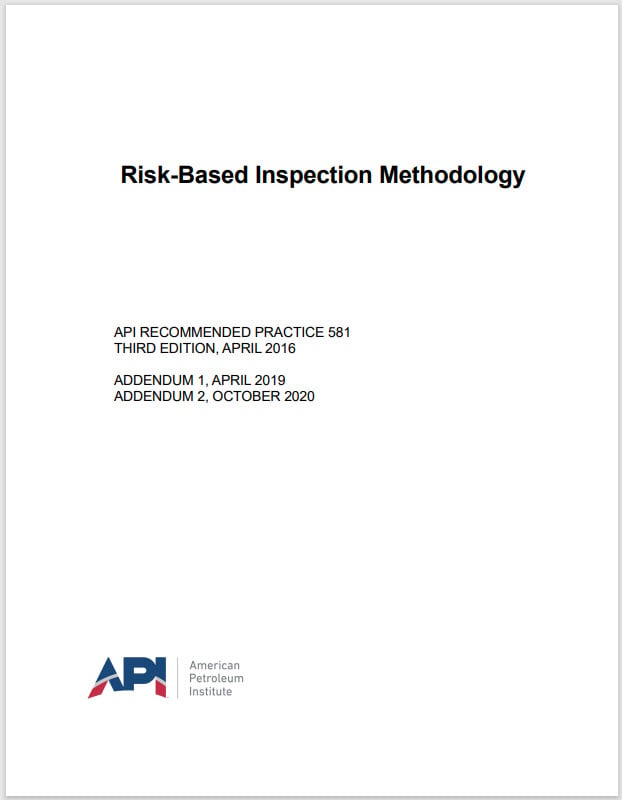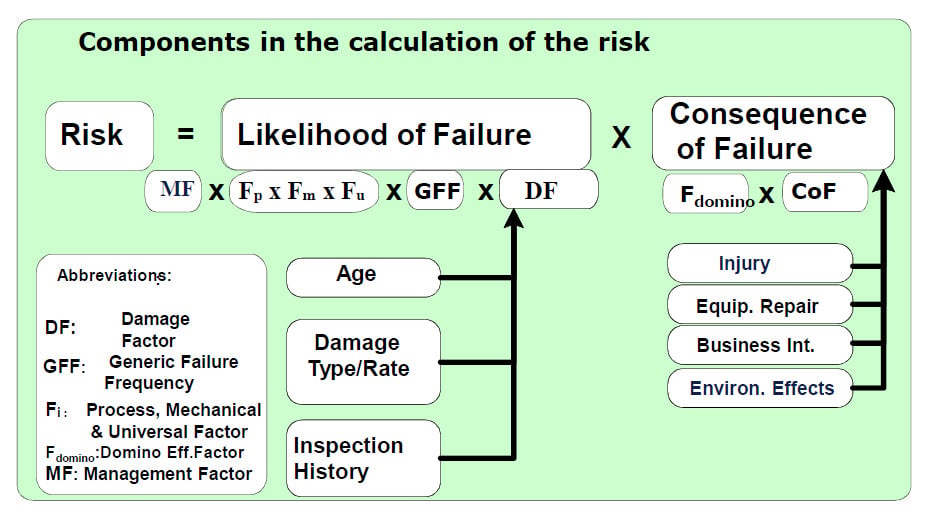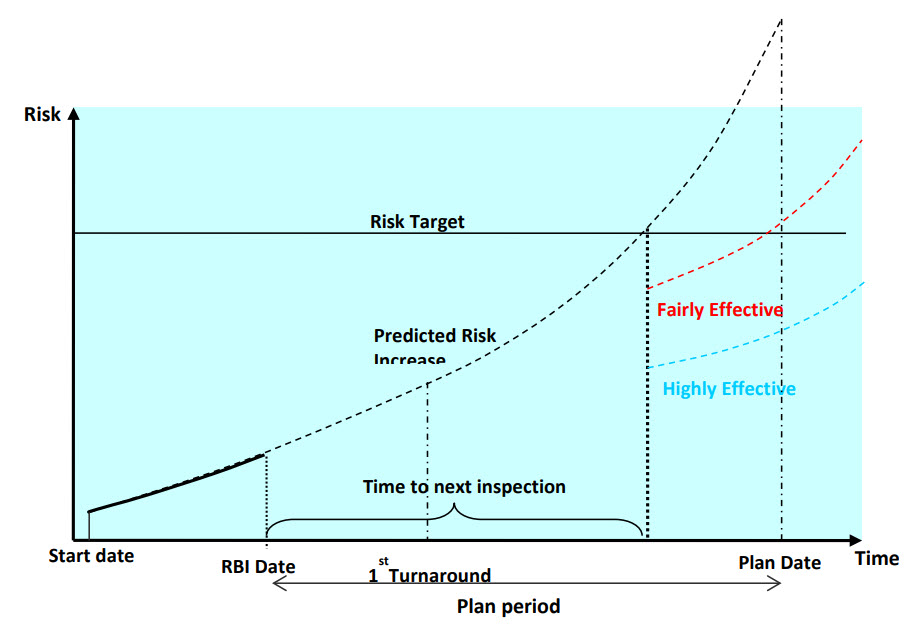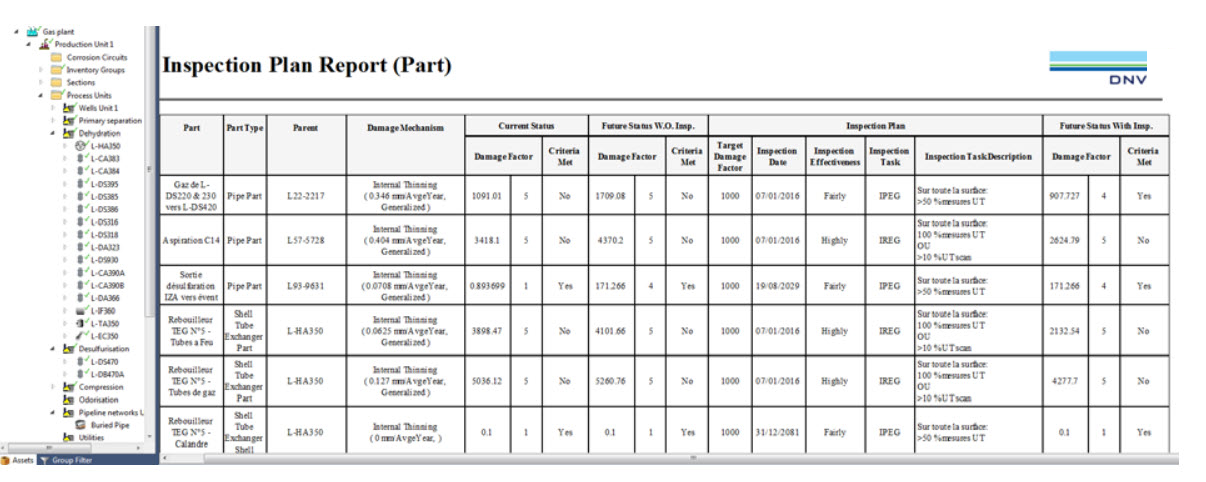Terminology Explained: What is Risk-Based Inspection (RBI)?
In today’s terminology explained: What is Risk-Based Inspection (RBI)?
The American Petroleum Institute (API) is where everything started. Risk-Based Inspection is method evolved mostly around API’s recommended practices 581 and 580. So, it is important to understand how the RPs had grown with the industry. Let’s try to go through the important elements of these publications:
In this post, Dr. Panos Topalis and I would like to answer: What is Risk-Based Inspection (RBI)?
API RP 581, Risk-Based Inspection Technology
In 1994 the American Petroleum Institute (API) decided to develop a Risk-Based Inspection (RBI) methodology. The methodology developed under API was published in 2000 as API PUBL 581, Base Resource Document – Risk-Based Inspection.
At the time, RBI was defined as “an integrated methodology that uses risk as a basis for prioritizing and managing an in-service equipment inspection program by combining both the likelihood of failure and the consequence of failure”.
The essential idea was (and continues to be): designing an inspection program which manages the risk of equipment failures. Three major goals have been identified in the publication:
- Define, quantify and rank the risk of process equipment failure to target the most important elements in a process plant
- Give the ability to review safety, environmental, and business-interruption risks in an integrated, cost-effective manner
- Systematically reduce the likelihood and consequence of failure by allocating inspection resources to high risk equipment.
So, the main objective of this RBI methodology was to provide the basis for managing risks through methods, coverage and frequency of inspections.
The document also highlights that RBI is about emphasising the benefits of inspecting specific areas of the process plant. It is known that a large percentage of the total unit risk will be concentrated in a relatively small percent of the equipment items. So, from all equipment items that are competing for attention, the idea is to review the inspection plan focusing on those components with the highest risk. As the process plant changes with on-going operations, inspection priorities and frequencies will be guided by the RBI process. This is where the concept of an evergreen RBI starts.

API RP 581
RBI analysis is expected not to concentrate only at inspection, equipment design, and maintenance records. It should also look at numerous process safety management issues and all other significant issues that can affect the overall mechanical integrity and safety of a process unit.
In 2008, the publication became a recommended practice called API RP 581, Risk-Based Inspection Technology. The most recent version is API RP 581, Risk-Based Inspection Methodology which was published in 2016. This edition includes over 1,000 technical changes when compared to 2008’s version.
One relevant change to this new edition is the definition of an application boundary: fixed equipment in refining, petrochemical, chemical process plants and oil and gas production facilities. This includes specific assets such as pressurized fixed equipment including pressure vessel, piping, tankage, pressure relief devices (PRDs), and heat exchanger tube bundles.
It also defines risk as the combination of probability of failure (POF) with consequence of failure (COF). Failure is then defined as a loss of containment from the pressure boundary resulting in leakage to the atmosphere or rupture of a pressurized component.
The concept of inspection effectiveness is introduced as part of the risk management process. As damage accumulates during in-service operation, risk increases which then should trigger an inspection activity of sufficient effectiveness. This shows signs of the RP evolving to account for human-error and reliability which is a subject of interest to many operators.
An important concept is clearly defined in the RP: inspection task is not the means to reduce the risk. An inspection task should be perceived as an opportunity to get a more accurate quantification of the damage present in the component so risk management can take place.
API RP 580, Risk-Based Inspection
Two years after the publication of API PUBL 581, the recommended practice API RP 580, Risk-Based Inspection was published.
This recommended practice was intended to: “provide guidance on developing a risk-based inspection (RBI) program for fixed equipment and piping in the hydrocarbon and chemical process industries”. It includes answers to basic questions such as:
- What is RBI?
- What are the key elements of RBI?
- How do I implement a RBI program?
The intention with this recommended practice was to provide users with the basic elements for developing and implementing a RBI program. It is based on the knowledge and experience of engineers, inspectors, risk analysts and other personnel in the hydrocarbon and chemical process industries.
RBI in DNV
As the API methodology was primarily geared to the needs of the refineries, DNV GL decided to further develop the quantitative RBI approach and that’s when we designed “Orbit Onshore”. The software tool aimed at providing a robust architecture and a user-friendly and efficient user interface. Orbit also included a fast interpolation approach for consequence analysis, based on the industry standard Phast consequence analysis model. Orbit Onshore can model any fluid if physical property data are available and it has a database of 1500 chemicals and about 1700 materials of construction (ASME). Currently, the software has been re-branded to DNV RBI, coming in four variants: RBI Onshore, RBI PowerPlant, RBI Offshore and Bespoke RBI.
- RBI Onshore is based on API 580/581, mainly used for onshore process plant RBI projects
- RBI Offshore is based on DNV RP G101, mainly used for offshore topside RBI projects
- RBI Power Plant is a specific variance for the power industry
- RBI Bespoke is for consultants and end users to configure their own RBI methodologies. This module has a modelling and formula engine which allows you to implement bespoke models for consequence of failure, probability of failure, risk matrix or inspection planning rules and recommendation library.
Now, how is the risk calculated?
Risk: POF X COF
Risk is defined as the product of the likelihood and consequence of failure. In RBI, we follow the same definition. In mathematical terms, the risk for a scenario s is:
Rs = Fs X Cs
Where,
- s = scenario number
- Fs = failure frequency (per year) for scenario s
- Cs =consequence (area in m2 , PLL, or cost) for scenario s
Remember the probability of failure (PoF) and the consequence of failure (CoF)? Same thing! CoF can be expressed in terms of the environmental/safety consequence effects and the economic effects. PoF is the product of the Generic Failure Frequency (GFF), statistical frequency of failure for a given equipment item and the damage factor (DF).

Calculation of risk for an equipment item

Evergreening: How RBI automatically proposes inspection dates/effectiveness
The following picture illustrates the process of determining the next inspection date and the inspection effectiveness. A maximum acceptable risk level is set by the user. A future evaluation date is then selected by the user (it is typically the date of the 2nd turnaround) and the risk is calculated as a function of time. If the risk at the future evaluation date exceeds the maximum acceptable level, an inspection is suggested. The intersection of the risk curve and the maximum acceptable line sets the next inspection date. The inspection may need to be included in the next turnaround, if it cannot be done on-stream. The inspection effectiveness is selected so that, after inspection, the risk does not exceed the maximum acceptable level at the future evaluation date.
The result is a list of inspections which are based upon the frequency and consequence of events. An example of a Part Frame Program report is shown below.

Part Frame Program report
The Report gives you the schedule of inspections within the five-year period starting from a specific Evaluation Date. Panos has also delivered an interesting webinar on the subject of Benchmark your RBI methodology. Very useful!
As one can see, RBI provides a rational method for creating inspection guidelines (including inspection dates and effectiveness).
Author: Victor Borges
2/26/2017 3:44:19 PM
